Memorials to Sacajawea
Sacajawea Creek, Montana, named by Lewis and Clark. It flows into the Missouri River near the confluence of the Musselshell (now known as Crooked Creek).
Statues
Louisiana Purchase Exposition Grounds, St. Louis, Bruno Louis Zimm, 1904.
Lakeview Terrace, now in City Park, Portland, Oregon, Alice Cooper , 1905.
Indian girl pointing the way for Lewis and Clark, Cyrus Edwin Dallin, 1910.
Bronze statue, erected by Federation of Women's Clubs and school children of North Dakota, Capitol Building grounds, Bismarck, North Dakota, Leonard Crunelle, 1910.
Group, Lewis and Clark and Indian girl, Public Square, Charlottesville, Viriginia.
Group, Sacajawea with Lewis and Clark, Charles M. Russell, National Cowboy Hall of Fame and Western Heritage Center, Oklahoma City.
Group , Lewis and Clark, York, and Sacagawea holding baby Jean Baptiste. Kansas City, Missouri, Case Park.
Mountains
Sacajawea Peak, Bridger Range, Montana
Sacajawea Peak, Wind River Range, Wyoming
Sacajawea Peak, Wallowa Range, Oregon
Sacajawea Peak, Lost River Range, Idaho
Paintings
Sacajawea on Indian pony, with child in papoose cradle, Henry Altman, 1905.
Sacajawea, State University of Montana Library, Edward Samuel Paxson, 1906
The Shoshonis Naming Sacajawea, Tullius P. Dunlap, 1925
Painting, Sacajawea in boat meeting Chinook party, Amon Carter Museum of Western Art, Fort Worth, Texas, Charles M. Russell.
Mural, Lewis and Clark at the Three Forks, Edward Samuel Paxson, Capitol, Helena, Montana.
Mural, Capitol, Helena, Montana, Charles M. Russell, 1912.
Markers
Grave of "Sacajawea of the Shoshonis," on the Shoshoni Reservation, near Lander, Wyoming, 1909.
Monument near Mobridge, South Dakota, 1929.
Sacajawea maker, near Tendoy, Idaho, west of Lemhi Pass.
Bronze tablet on wall of Bishop Randall Chapel, Shoshoni Cemetery, Wyoming, 1931.
Granite marker, Shoshoni Cemetery, for Bazil, Baptiste, and Baptiste's daughter Barbara Meyers, 1932.
Boulder with bronze tablet, honoring meeting place of Sacajawea and her brother, Camaeahwait, near the confluence of Horse Prairie and Red Rocks creeks, Armstead, Montana, 1914.
Boulder and brass tablet erected by Daughters of American Revolution, near Three Forks, Montana, 1914.
Lakes
Lake Sacajawea, Longview, Washington
Lake Sakakawea, (formerly Lake Garrison), North Dakota
Interpretive Center
Sacajawea Interpretive Center, Pasco, Washington
Historic Route
Sakakawea Trail
Source: Sacajawea
by Harold P. Howard
University of Oklahoma Press

8LEWIS & CLARK TRAIL
Sacagawea
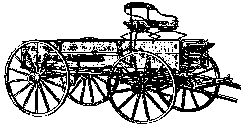
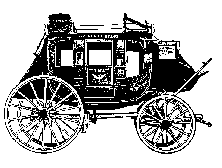

This page was last updated: February 1, 2010

Copyright © 2000 Larson Century Ranch, Inc. ~ All Rights Reserved
P. O. Box 1982
Clarkston, WA 99403
Telephone: 509-758-5445
FAX: 509-758-5701
E-Mail: Sales@LarsonCenturyRanch.com

Web Design: Design Carte
July 28, 1805 - Sacajawea was a remarkable woman in time of sorrow.
"Our camp is precisely on the spot that the Snake Indians were encamped at the time the Minnetares of the Knife River first came in sight of them five years since. From hence they retreated about three miles up Jefferson's River and concealed themselves in the woods, the Minnetares pursued, attacked them, killed 4 men, 4 women, a number of boys, and made prisoners of all the females and four boys, Sacajawea was one of the female prisoners. I cannot discover that she shows any emotion of sorrow in recollecting this event, or of joy in being restored to her native country; if she has enough to eat and a few trinkets to wear I believe she would be perfectly content anywhere..."
Over the years, a number of linguistic attempts to decipher the mystery of her name have been published. Shoshoni advocates claim her as "Sacajawea" (pronounced sak´ä-jä-we-ä), a form of her name which has become widely popularized both in spelling and pronunciation, especially in the Far West. This leads to complications however, because her name never was spelled "Sacajawea" by her contemporaries during her lifetime. Moreover, "Sacajawea" allegedly means the equivalent of "boat launcher" or "boat pusher" in Shoshoni, which contradicts Lewis and Clark's primary documentation, "bird woman".
The "Sacajawea" spelling derives from the 1814 narrative of the journey, a secondary source published two years after Sacagawea's death. The narrative was edited by Nicholas Biddle, a classical scholar who never met Sacagawea, so never heard how she pronounced her own name. Biddle worked from the captains' original longhand journal entries, correcting spelling and grammar, and substantially abridging many daily entries. Biddle gave no clue as to why he decided upon the "Sacajawea" spelling, when all of the primary documents available to him spelled the name with a "g". Apparently, the only basis for his spelling the name with a "j" was editorial prerogative.
In addition, certain North Dakota Hidatsa advocates vigorously promote a "Sakakawea" (pronounced sä-kä´kä-we-ä) spelling and pronunciation form of her name. Similarly, the "Sakakawea" spelling is not found in the Lewis and Clark journals. To the contrary, this spelling traces its origin neither through a personal connection with her, nor in any primary literature of the expedition. It has been independently constructed from two Hidatsa Indian words found in a dictionary titled: Ethnography and Philoloqy of the Hidatsa Indians, published by the Government Printing Office, Washington, D.C., 1877. Compiled by U. S. Army Surgeon, Dr. Washington Matthews, sixty-five years following Sacagawea's death, the words appear verbatim in the dictionary as "tsa-ka-ka, noun; a bird," and "mia [wia, bia], noun; a woman." Dr. Matthews would later explain: "In my dictionary I give the Hidatsa word for bird as 'Tsakáka.' Ts is often changed to S, and K to G, in this and other Indian Languages, so 'Sacága' would not be a bad spelling...but never 'Sacaja' [for bird]." On page 90 of Dr. Matthews dictionary it is explained that there is no j included in the Hidatsa alphabet, and that g is pronounced as a "hard g."
This researcher agrees with the sources cited above, that the matter has been decisively treated by the disciplines of orthography, ethnology, and philology, with the effect of formally establishing the Sacagawea spelling and pronunciation. Hopefully, over time, the American "editorial ethic" will edge toward uniform adoption of the Sacagawea form. We owe it to America's most famous Indian heroine at least to correctly spell and pronounce her name!
May 14, 1805 - The boat Sacajawea was riding in was hit by a high wind and nearly capsized. Her calmness earned her compliments from the Captains.
"The Indian woman to whom I ascribe equal fortitude and resolution, with any person onboard at the time of the accident, caught and preserved most of the light articles which were washed overboard".
With respect to the latter, a popular theory that evolved through a circumstance of mistaken identity purports that she died April 9, 1884, and was buried at Fort Washakie, Wind River Indian Reservation, Wyoming. Contravening that theory is decisive documentary evidence that traces a complete chronology of her life, conclusively placing her at Fort Manuel (South Dakota), at the time of her death, December 20, 1812.
Lewis and Clark identified Sacagawea as a woman of the "Snake" (Shoshoni) nation who had been captured and enslaved by the Hidatsa Indians of Knife River (North Dakota) five years prior to first meeting her in November 1804, at their Fort Mandan winter headquarters. She then was about 17 years old, and pregnant. Her "husband" was French-Canadian fur trader, Toussaint Charbonneau, who resided among the Hidatsa and Mandan Indians. Toussaint had purchased Sacagawea from the Hidatsa, and claimed her as his "wife" a la facon du pays (after the fashion of the country).
Toussaint, who was conversant in French and Hidatsa was hired as an interpreter by the captains. Sacagawea, who spoke both Shoshoni and Hidatsa, was recruited as an "interpreter through Toussaint." The Shoshoni woman's pregnancy resulted in the birth of a son (Jean Baptiste Charbonneau) at Fort Mandan, February 11, 1805. The boy, whom Clark nicknamed "Pomp" or "Pompy", accompanied his parents to the Pacific and back to Mandan during 1805-1806.
The commanders recognized that Sacagawea could make a significant contribution to the party if it encountered the Shoshonis when it reached her homeland in the "Rock Mountains." This foresight would later be borne out when she proved vital as an interpreter among her own people, negotiating for horses needed by the explorers to cross the "tremendous mountains" that lay before them.
With respect to her name, it is found spelled fourteen times total, by Lewis and Clark, and once by Sergeant John Ordway in the explorer's original manuscript journals, primary documentary sources. Although their flair for inspired spelling created some interesting variations, in every instance, including three additional spellings on Clark's maps, all three of the journalists who attempted to write it were consistent in the use of a "g" in the third syllable. Lewis gave not only his rendition of the spelling of her name but also its meaning. His journal entry for May 20, 1805, reads: "a handsome river of about fifty yards in width discharged itself into the shell [Mussellshell] river...this stream we called Sah-ca-gah-we-ah or bird woman's River, after our interpreter the Snake woman."
Lewis and Clark history scholars, together with the U. S. Geographic Names Board, the U. S. National Park Service, the National Geographic Society, Encyclopedia Americana, and World Book Encyclopedia, among others, have adopted the Sacagawea form. The Bureau of American Ethnology, as early as 1910 had standardized the Sacagawea spelling in its publications. Although Sacagawea was a Shoshoni by birth, her name traces its etymology to the Hidatsa Indian tribe, among whom she lived most of her adult life. The name derives from two Hidatsa Indian words: sacaga, meaning bird, and wea, meaning woman. It is pronounced sä-cä´gä-we-ä, with a hard "g". Clark would later explain that in taking Indian vocabularies "great object was to make every letter sound."
The History of the Lewis and Clark Expedition
written by
Irving W. Anderson
Past President of the
Lewis and Clark Trail Heritage Foundation, Inc.
Sacajawea? Sakakawea? Sacagawea?
Spelling ~ Pronunciation ~ Meaning
by Irving W. Anderson
This article first appeared in the Summer, 1975 issue of We "Proceeded On"
History has accorded the Shoshoni Indian woman member of the Lewis and Clark Expedition a most novel place in the hearts and minds of generations of Americans. That her fame is deserving is evident from historical records. However, early in the twentieth century she was elevated by romanticists to a legendary status far beyond her mortal achievements, and placed at the very pinnacle of renown as America's most famous Indian heroine.
The deeds of Sacagawea are well known to students of the Lewis and Clark Expedition. But a curious mystique completely envelopes two dimensions of her life's story:
1) A disparity persists among her admirers concerning the derivation, spelling, pronunciation, and meaning of her name; and
2) A dispute has raged for nearly a century, concerning her fate following the expedition, especially events relating to the time and place of her final hours.
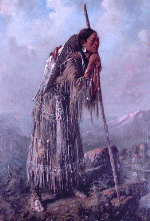
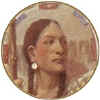
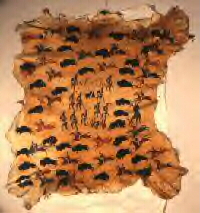
Shoshone Elk hide showing a horseback buffalo hunt.
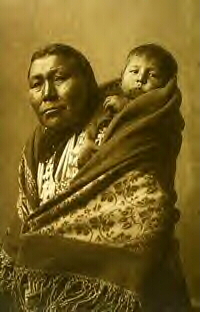
Hidatsa Mother
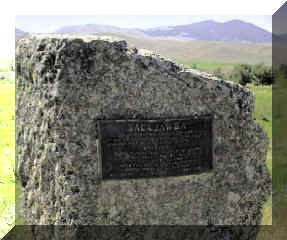
Sacagawea was born near this spot in 1786."
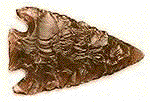
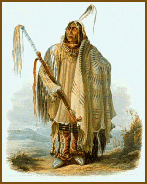
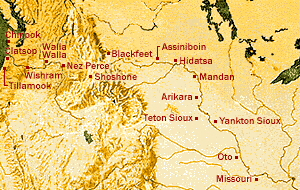
Some tribes the Corps encountered.
Bodminn Indian
July 28, 1805 - Sacajawea was a remarkable woman in time of sorrow.
"Our camp is precisely on the spot that the Snake Indians were encamped at the time the Minnetares of the Knife River first came in sight of them five years since. From hence they retreated about three miles up Jefferson's River and concealed themselves in the woods, the Minnetares pursued, attacked them, killed 4 men, 4 women, a number of boys, and made prisoners of all the females and four boys, Sacajawea was one of the female prisoners. I cannot discover that she shows any emotion of sorrow in recollecting this event, or of joy in being restored to her native country; if she has enough to eat and a few trinkets to wear I believe she would be perfectly content anywhere..."
August 8, 1805 - Sacajawea was attached to her country and kin.
"The Indian woman recognized the point of a high plain to our right which she informed us was not very distance from the summer retreat of her nation on a river beyond the mountains which runs to the west. This hill she says her nation calls the Beaver's Head, as it resembles the head of that animal. She assures us that we shall either find her people on this river or on the river immediately west..."
August 8, 1805 - Sacajawea was attached to her country and kin.
"The Indian woman recognized the point of a high plain to our right which she informed us was not very distance from the summer retreat of her nation on a river beyond the mountains which runs to the west. This hill she says her nation calls the Beaver's Head, as it resembles the head of that animal. She assures us that we shall either find her people on this river or on the river immediately west..."
August 17, 1805 - Five years later, Sacajawea had an emotional reunion with her brother, Chief Cameahwait; it was Sacajawea who secured the horses that the Expedition needed.
"Clark saw Sacajawea, who was with her husband 100 yards ahead, began to dance and show every mark of the most extravagant joy, turning round him and pointing to several Indians, whom he now saw advancing on horseback, sucking her fingers to indicate that they were of her native tribe"...
"She came into the tent, sat down, and was beginning to interpret, when in the person of Cameahwait she recognized her brother; She instantly jumped up, and ran and embraced him, throwing over him her blanket and weeping profusely..."
October 19, 1805 - The presence of Sacajawea was an invitation to the Indians that the white people came in peace.
"The sight of this Indian woman, wife to one of our interprs. confirmed those people of our friendly intentions, as no woman ever accompanies a war party of Indians in this quarter..."
November 20, 1805 - Sacajawea, always pleasing the Captains.
"one of the Indians had on a roab made of 2 Sea Otters Skins the fur of them were more butifull than any fur I had ever seen both Capt. Lewis & my Self endeavored to purchase the roab with differant articles at length we precurred it for a belt of blue beeds which the - wife of our interpreter Shabono wore around her waste..."
November 24, 1805 - Reaching the place where the Columbia River empties into the Pacific Ocean, the members of the Expedition were given the right to vote on the location where they would settle for the winter.
Sacajawea (Janey) in favor of a place where there is plenty of Potas.
January 7, 1806 - A whale had washed ashore, near present day Seaside/Cannon Beach, Oregon. Sacajawea accompanied the group to the ocean.
"...she observed that she had traveled a long way with us to see the great waters, and that now that monstrous fish was also to be seen,..."
July 15, 1806 - Sacajawea proved a valuable guide on the return journey. She remembered trails from her childhood; the most important trail was a large road that passed through a gap in the mountain, which led to Yellowstone River. Today, it is known as Bozeman Pass, Montana.
August 14, 1806 - End of the Journey for Sacajawea... returning to the Hidatsa-Mandan Village.
" I offered to take the little son a butifull promising child who is 19 months old to which they both himself & wife were willing provided the child had been weened. They observed that in one year the boy would be sufficiently old to leave his mother & he would then take him to me if I would be so friendly as to raise the child ... to which I agreed". Capt. Clarks' Journal Entry August 17, 1806
Some tribes the Corps encountered.
Lewis & Clark Expedition
Lewis & Clark Expedition